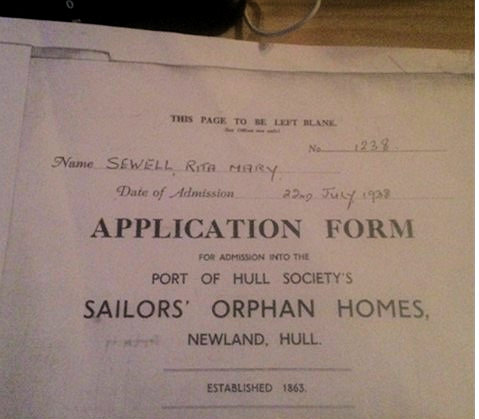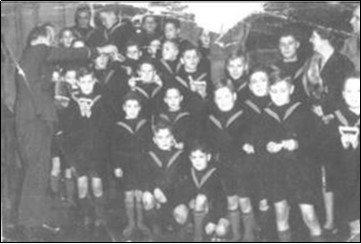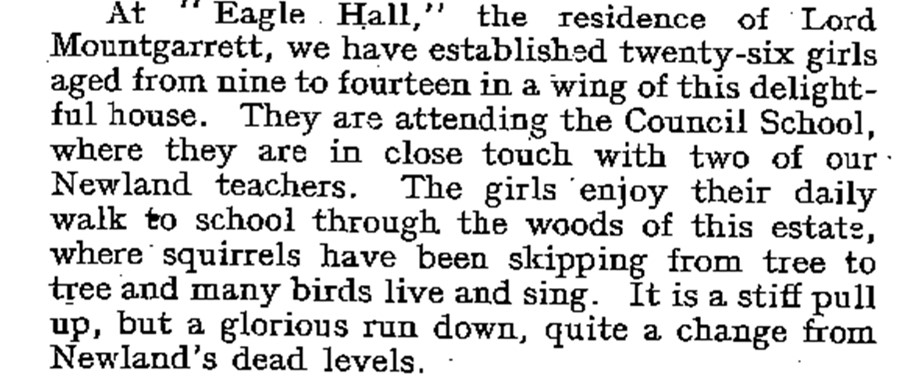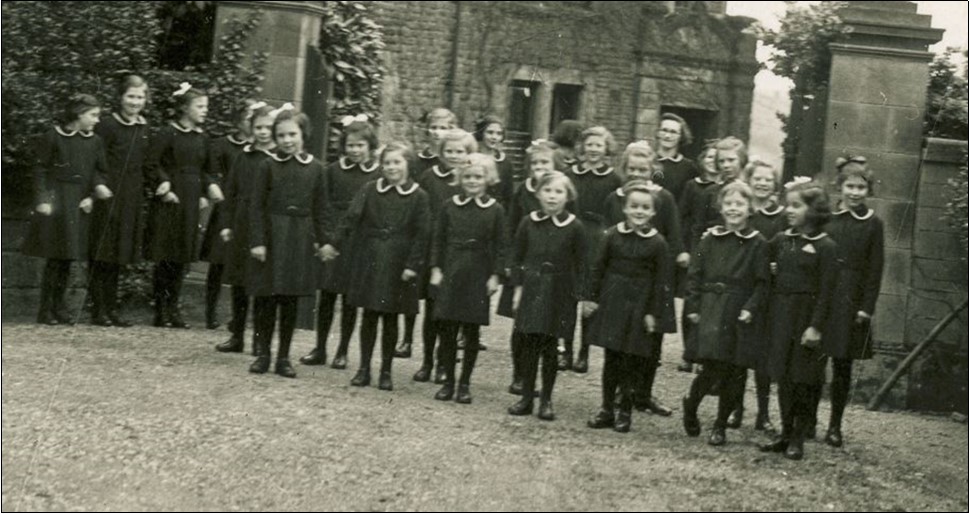By Richard Jones
This article was published in the August 2016 edition of Soul Search, the Journal of The Sole Society
Ed: Richard Jones sent me a document he has been writing along with his cousins about how he discovered his mother’s siblings and their life in the 20th century. Many of them were sent to an orphanage during WW2 and what follows is an account of their time there. An article on how he traced his mother’s siblings and their children, which will include his family tree back to the 18c, will appear in the next edition of Soul Search.
Just over a year after their mother’s death, my mother, most of her sisters and her brother Kelvin were put into the Newland Homes Orphanage in Hull, a hundred miles away from their family home
in Leicester. The orphanage was founded in 1866, and was run by the Hull Society’s Sailors Association. My mother’s two oldest sisters Marjorie, 16 and Doreen, 18 most likely stayed at the family home, they were already too old for entrance into the orphanage.

Although I have never heard an exact reason why the children were put into an orphanage, it is most likely simply that their father could not support and take care of his children. At this time their father was a painter in his brother’s or father’s business working in Manchester. He was likely away from the home in Leicester most of the time, and therefore apparently decided he could not care for or afford the care for his youngest children. The orphanage actually charged a guinea (21 shillings sterling) a month for their upkeep and required that the parents provide them ‘leaving clothes’ at the appropriate time. Orphanage communications show that this fee was rarely paid on time, if at all.
The entry records of the orphanage show that on the 22nd of July 1938, my mother (then age 9), with five of her sisters: (Veronica) Joyce, 13, Mavis, 12, Iris, 10, Berenice, 7, Pauline, 6, and her brother Kelvin, 5 were admitted into the Port of Hull Society’s Sailors Orphan Homes on the Cottingham Road, Newland, Hull. The current name of the organization is ‘The Sailor’s Children’s Society and they no longer operate this particular orphanage.
Just over a year after the younger Sewell Children had been put into the orphanage, WW2 began. It was during the first two years of the war that my mother and her sisters and brothers most likely experienced the most frightening times of their lives. They had by no fault of their own taken up home in the second most bombed city in WW2 – Hull. Hull was subject to over 80 raids within the city boundaries during the war, with a conservative estimate of 1200 civilians killed and 95% of its housing stock destroyed or damaged. Indeed, to this day Kelvin’s children recall stories from their father about taking cover from the German bombs blitzing the port of Hull.
From all reports, the orphanage at some point in 1940 and 1941 took some damage from an incendiary bomb attack and the children were very much at risk. Due to the kindness and work of a lot of people the children were evacuated to cluster of ‘stately homes’ near Pately Bridge, Harrogate in the West Riding of Yorkshire.

Sadly for the Sewell children, it was the practice of the orphanage that girls were released when they were 15 and boys 14, the Sewell children were by no fault of their own, one by one eligible to be cast out to fend for themselves, split up as a family, in the middle of World War II. So, at the time of the evacuation of the Orphanage to Pately Bridge in August 1941 it is entirely conceivable that both Joyce and Mavis may have already actually left the orphanage. The siblings remaining were most likely Iris, 13, Rita Mary, 12, Berenice, 11, Pauline, 9 and their Brother Kelvin still only 8.

The children were evacuated according to their age group and whether they were a boy or a girl. It is most likely that the Sewell girls were in Eagle Hall and Kelvin in Castlestead Hall. My cousin Glen recalls his mother saying that the girls actually lived in the servant’s quarters in Eagle Hall.
My cousin Glen also recalls another story from his mother that the school buildings (Council School) in Pately Bridge were ‘two miles away across the moors’. The girls and their brother most likely walked this distance every day, come rain or shine, as England endured World War II. A ‘stiff pull’ indeed per the article above from Ashore and Afloat, the quarterly publication of the sailors orphanage homes in Hull. Their mother dead, separated from their elder sisters, pushed away by their father, then dispersed to a country at war, the Sewell children did not have an easy beginning to their lives.
According to the January 1944 edition of Ashore and Afloat Iris is no longer listed as resident. Iris most likely left the orphanage in 1943. My mother’s leaving records show she left on 6th November 1944, just a couple of months before her 16th birthday. Berenice would likely have left towards the end of 1945.

It would appear that as the sisters grew too old to be at orphanage they went back to the family home on the Narborough Road in Leicester. However this was hardly a loving family’s welcome. The family consisted of their step mother Hilda and an ailing father barely able to work. Indeed, a letter from the father sent to the orphanage in 1945 explaining the difficulty in paying for the remaining child, Kelvin, indicates that almost all of the income the family was living on was board paid by Rita and Iris and National Sick Pay, not by any money’s earned by Hilda or their father. Fortunately, most of the Sewell Children found a job quickly or moved in with friends just as quickly.
Kelvin, was with a group of boys at Castlestead House. Castlestead House is quite unique as it was built on the site of an old Roman Villa in 1862 with a relief image of Caesar Augustus on one wall. Today the house is used for flats, as rather oddly so is the original orphanage in Hull.
It must be said though that it would appear that the treatment of the orphans appears to have been as good as conditions could allow. As the orphanage was ultimately sponsored by the community and funded through the Sailors Society the children appeared to have been treated well during these hard times. Indeed during the war years there were several delegations from Hull that came to visit them.
As previously mentioned the children did attend school, the boys often worked in the fields as well, but they were seemingly prepped for the future with good attention to the basics. As the note on my mother’s school release papers (14th May 1943) at the orphanage reads: ‘Excellent progress. Written work of a very high standard, neat and methodical’, with a character note of ‘very sound and reliable’.
Interestingly enough education was a key theme of both my mum and dad and somehow it was clearly instilled in my mother at the orphanage. My cousin recalls that his mother also had extraordinary good diction as well, not a typical result of an orphanage upbringing, but maybe the result of some interactions with the family of Lord Mountgarrett, the owner of Eagle Hall, as well as the Hull Society’s focus on education.
At the end of the war only Pauline and Kelvin remained to make the return journey from Pately Bridge to Hull. They would have both been eligible to leave the orphanage by the end of April 1947. The boys returned to Hull in 1946 and the girls sometime in February 1947. The return journey for the girls postponed due to heavy snows that winter.
Although most of the Sewell children returned to Leicester my Uncle Kelvin’s story is quite different. When I discussed her dad’s story with daughter Donna, it would appear that he told them he ‘ran away’ from the orphanage and joined the Canadian Army (Black Watch) when he was 16. Since he was born in 1933 that meant he was still possibly in the orphanage in 1948 or 1949 years after the rest of the children of the orphanage had returned to Hull, although he would have been entitled to leave in 1947.
It turns out that the orphanage were very instrumental in helping Kelvin. My Uncle Kelvin actually officially emigrated to Canada as part of a program that the orphanage were working on with the British Dominions Emigration Society. He became the ward of Air Vice Marshall Clifford McEwen who had recently retired from the Royal Canadian Air Force. The Air Vice Marshall had run the #6 (RCAF) Group – Bomber Command based in Yorkshire not far from where the Sewell Children lived in Pately Bridge. Kelvin left England on the R.M.S. Ascania on July 30th 1948 sailing from Liverpool, England to Montreal, Canada where he would work before joining the Canadian Army at the University Club of Montreal. As described in the family story above, Kelvin became a Canadian Citizen and served in the Canadian Army and then in the Navy.
When Kelvin left the orphanage there was a period from 1948 to 1950 where his letters to the orphanage superintendent indicate considerable loneliness without his sisters and the support of the orphanage staff. Clearly because of the large amount of his correspondence in the orphanage’s records, orphanage staff were still a part of his family at this point in his life.
